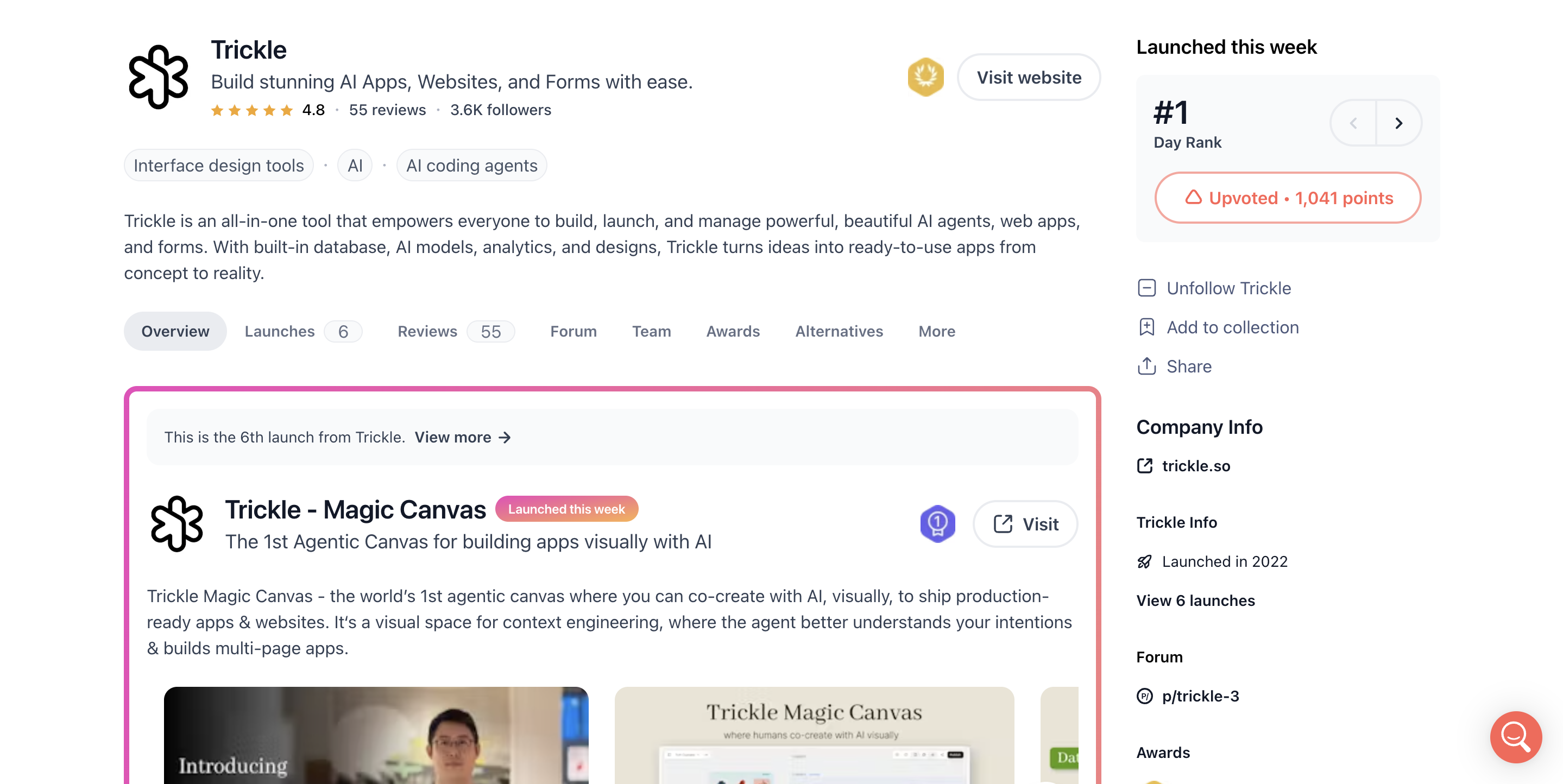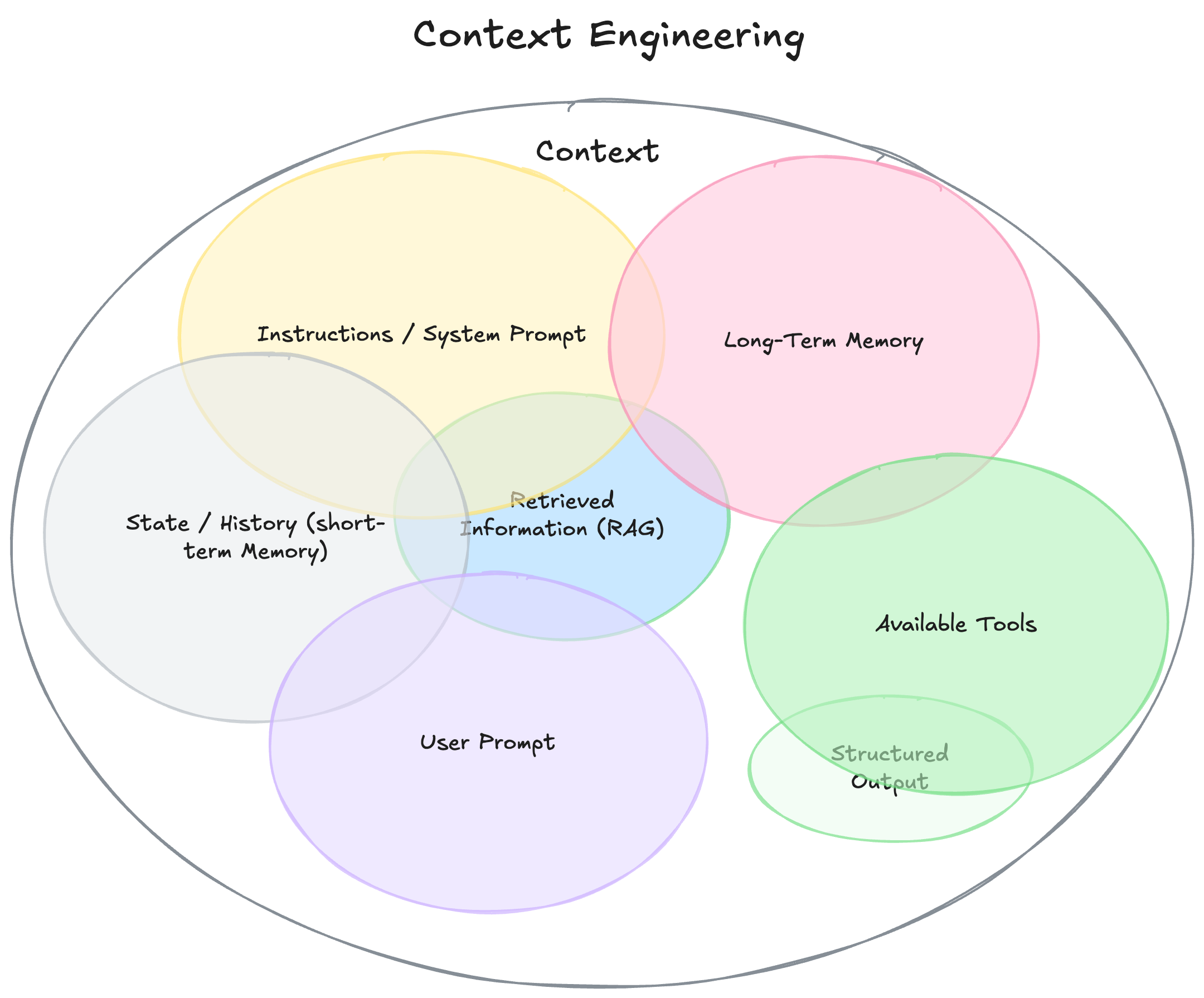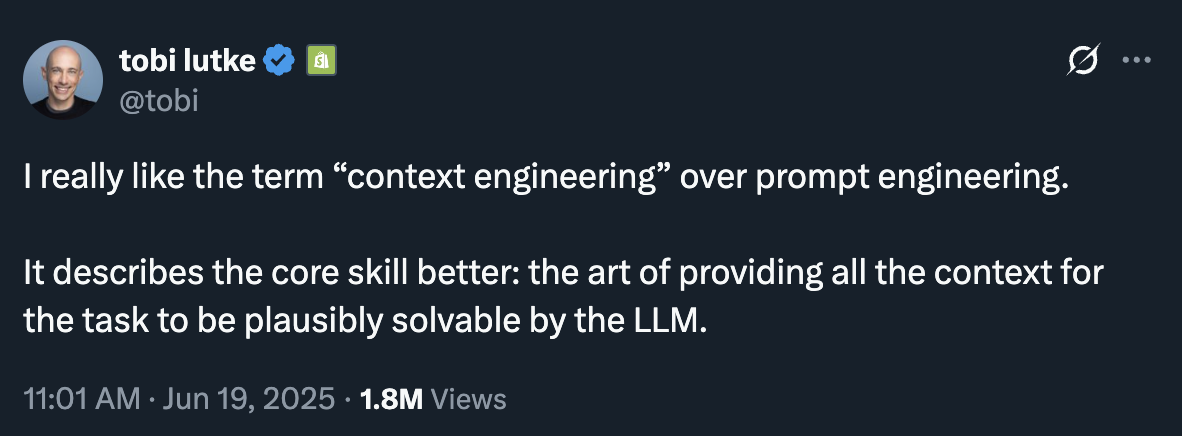Trickle Canvas: Visual Context for Real AI Co-Creation
Last week, we launched Trickle Canvas, a major step forward in our mission to redefine how humans and AI build software together.
Introducing Trickle Magic Canvas (Source: YouTube - @trickleai)
We believe that for AI to truly assist in creation, it needs more than just a prompt. It needs the right context, structure, and a shared space to think and build alongside people. That’s why we designed Canvas — a visual canvas where users and AI can collaborate in real time, with every action, asset, and intent forming part of the evolving context.
Trickle Canvas brings design, logic, and generation into one continuous flow. You can drag in assets, define structure, track history, and build fully functional apps page by page, version by version, with AI acting as an intelligent partner throughout.
This vision resonated with the community in ways we didn’t anticipate.
We’re proud to share that Magic Canvas ranked as the #1 Product of the Day and the #1 Product of the Week on Product Hunt. This milestone reflects not only the work our team has invested in building Trickle, but also a growing shift toward more dynamic, context-aware, and collaborative ways of working with AI.

Trickle launch page on Product Hunt (Source: Product Hunt)
What the Community Is Saying
Here’s what people have been sharing on Product Hunt and Twitter — and honestly, there are far more messages than we can fit here.

Love from Product Hunt community (Source: Product Hunt)
They love how natural it feels to work with AI inside a visual environment, and how much time it saves from idea to deployment. Whether it’s landing pages, onboarding flows, or internal tools, Trickle makes it possible to co-create with AI in a way that feels intuitive and production-ready.
And truthfully, there are far more amazing comments than we can fit here. We’re beyond grateful for all the love.
From Prompt to Context: How Trickle is Productizing Context Engineering
With the release of Trickle 1.5, we introduced not only major improvements to interface and interaction design, but also meaningful upgrades to Agent Mode (automatic continuation, error recovery, and smoother AI interactions) and RAG Mode (retrieval-augmented generation). Behind these changes lies a core shift in thinking: Context Engineering.
Introducing Trickle 1.5 (Source: YouTube - @trickleai)
Why Prompt Alone Isn’t Enough
Over the past year, a wave of “vibe coding” tools have emerged — enter a single prompt, and AI builds a webpage. While initially exciting, these tools quickly revealed their limits: models often go off track, misinterpret intent, or fall into logical loops. The core issue isn’t that the models aren’t powerful enough — it’s that the context isn’t rich enough.

Klaas on the pitfalls of vibe coding: when LLMs derail, hallucinate, and spiral into loops. (Source: @forgebitz)
Most current AI builders are still stuck in the paradigm of prompt engineering: you describe what you want in text, and the model returns a static result. But a prompt is only one piece of the broader context. It may define the immediate task, but it leaves out critical elements like constraints, structure, prior actions, and semantic goals.
As Hugging Face engineer Philipp Schmid said:
“The magic isn’t in a smarter model or a more clever algorithm. It’s in providing the right context for the right task.”
To move from impressive demos to real, reliable tools, we need to go beyond prompting. We need context — and we need to engineer it deliberately.
What Is Context Engineering?
Context engineering is the process of constructing and organizing all the information a language model needs to reliably perform a task.

Context Engineering (Source: philschmid.de)
It’s not just about writing better prompts. It’s about systemically shaping the model’s environment — combining task definitions, behavioral history, multimodal inputs, user preferences, constraints, and examples into a coherent context window that guides the model toward more accurate outputs.

Tobi Lütke believes that the real skill lies not in prompt engineering, but in the art of context engineering. (Source: X @tobi)
In Trickle 1.5, we began turning this philosophy into product reality. The result is a new interface model: Canvas as Context.
Trickle Canvas: Productizing Context Engineering
Trickle's new paradigm centers on two key shifts:
1. Design and Code Happen in the Same Space
We no longer treat AI output as static. What you see is not just the result — it’s the process of construction. In Canvas, visual layout and semantic logic are built together.
2. Human-AI Co-Creation as a Core Workflow
Users and AI collaborate in a shared space. Rather than working in a black box, AI now acts transparently within a visible, editable context.
Canvas Core Capabilities
1. Canvas is the Context
Everything AI needs to generate is placed on the canvas: assets, rules, user notes, search results. These aren’t decorative — they’re active inputs in the model’s decision process.
2. Output Is Deployable, Functional Code
Unlike tools that generate mockups, Trickle delivers production-ready pages that are directly editable and deployable.
3. Multi-Page, Parallel Preview
Users can preview multiple pages side-by-side within the same canvas, enabling broader structural planning and consistent UX flows.
4. Branchable Versioning
Any page or component can fork into a new version and continue evolving. All states are visually tracked, supporting fast iteration and recovery.
5. Real-Time Visual Editing
Drag images, components, or data sources onto the canvas. Every visual action updates the semantic context instantly.
6. Agent-Orchestrated Tool Use
The AI autonomously selects and uses internal tools — layout engines, image generators, code editors — based on task requirements. Users don’t need to specify tools manually.
7. Follow Mode: Contextual Generation Focus
As the AI generates in one section, the canvas automatically follows and focuses on that area, ensuring users and AI remain in sync.
Visualizing Context Engineering
Trickle isn't just about giving AI more input — it's about helping it make sense of those inputs. We take what used to be invisible prompt logic and turn it into visible, editable interactions. This is the real work of context engineering, made productized.
What That Looks Like:
Structured Context Assembly
Every user interaction becomes a structured signal — position, version, semantics, history — that informs generation.
Canvas as a Multimodal Context Container
Trickle replaces linear prompts with a spatial, visual environment where images, structure, behavior, and logic coexist.
Context Evolves Through Interaction
Every click, drag, and version switch immediately updates what the model sees and understands.
Human-in-the-Loop Iteration
Users can generate multiple versions, fork directions, and fine-tune results collaboratively. The model doesn’t just generate content — it participates in a guided, shared iteration process.
From Demo to Durable
Trickle is not just building a better AI generator. We’re redefining how humans and AI work together to build software. By turning context engineering into an interactive, visual process, we give users control over how AI understands their goals.
When humans and AI co-construct context, the model stops guessing — and starts building what you actually meant. That’s how we move from demo to product.